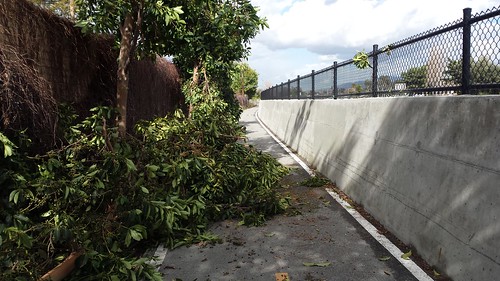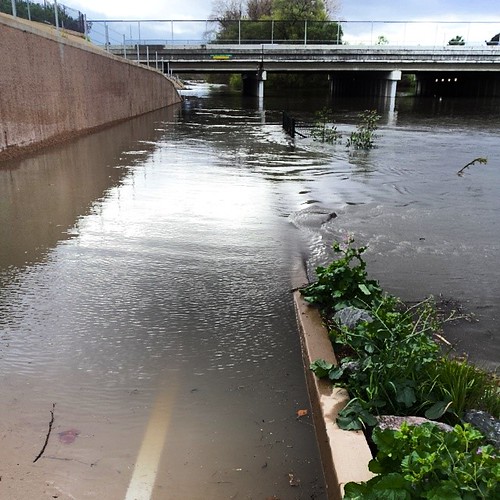
Happy Friday, all. I occasionally participate in the weekly BikeSchool Twitter conversation that takes place every Thursday night beginning at 6 P.M. California time. A “professor” asks a series of questions to generate discussion on bike-related topics.
Last night’s guest professor, Matthew Dyrdahl, is the Bicycle & Pedestrian Coordinator for the city of Minneapolis, MN. Among his many good conservation starters, he asked if people “should” use a path next to a road if it’s available.
****Q10 If there is a shared-use path (aka: a trail) adjacent to the roadway, should people on bikes use it? #bikeschool
— matthew dyrdahl (@matthewdyrdahl) April 29, 2016
I think most people discussed this in terms of using a shared path, i.e. if there’s heavy pedestrian usage, should cyclists use the path? Given Matthew’s position as a Bicycle and Pedestrian Coordinator, I realize now that he maybe asked this in terms of cyclist and walker conflict on shared trails.
Last night, though, I assumed Matthew was asking about this in terms of the motoring public’s perceptions and, more specifically, mandatory sidepath laws. In other words, should cyclists be required to use a sidepath if one is available next to the roadway? I answered:
#bikeschool Q10 mandatory sidepath laws evil. If facility good, people will use it. If facility bad, shouldn't be compelled.
— Richard Masoner (@cyclelicious) April 29, 2016
To expand on my 140-character summary: If a bike facility is worth using, people will naturally use it. If the path off to the side of the road is not worth using, the cyclist shouldn’t have to be legally compelled to use it.
We don’t ride our bikes in traffic because we think it’s fun to get out in front of people in cars, nor do we do so because we’re ignorant or stupid or lack ‘common sense.’ We do it because we need to get from Point A to Point B. If a good path is available nearby, I’ll probably use it. If I’m riding on a narrow road with heavy traffic in spite of the presence of a nearby path, however, there’s a good reason I avoid that path.

Those with a windshield perspective often don’t understand why that guy on the bike is on the road in spite of the perfectly usable bike path just over yonder. Even many policy savvy and informed cyclists wonder why cyclist’s shouldn’t be compelled to use a bike path. Let me list a few reasons:
- Bad Design: I’m blessed to have decent, usable paths in my area, and a few are even excellent, but bike paths are often poorly engineered. My usual commute route, for example, floods underneath Highway 101 in San Jose, CA when more than a tenth of an inch of rain falls. The maddening thing is that this is by design: the airport economy parking lot funnels all of their storm drain outlets directly onto the trail. The airport tarmac itself drains to the Guadalupe River about 50 yards north of this location, leading to more trail flooding in after even the slightest rainfall.
We have a similar drain on the Los Gatos Creek Trail, where a school parking lot storm drain dumps directly onto the trail underneath Leigh Avenue. Who designs this stuff?
Anybody who’s ridden a bike can go on forever about design flaws. A real winner is this barbed wire fence immediately adjacent to the Ralston Avenue sidepath in San Mateo County, California. Any highway engineer who designed a road that’s guaranteed to cause injury in the slightest crash would lose his engineering license and his job.

- Poorly maintained: The existence of a path near a roadway doesn’t mean it’s usable. Sidepaths are at the bottom of the list when it comes to allocating scarce maintenance funds. It could be flooded; blocked by mud and fallen trees; covered in horse manure; or have gaping, bike-eating potholes.
- Exceptions can be subjective, and a ticketing authority may not agree that a foot of snow might be impassable on your bike, because hey, look, there’s a sled dog team pulling a young, fit, professional Olympic athlete on a fatbike on that path right now so what’s your problem?
- Public safety: As I’ve mentioned previously, personal safety is a thing. The Silicon Valley Virtual Route Scouts have struggled with the question of directing new cyclists onto some of our more isolated trails. Every week, we have news about rapes, robberies, assaults, and other violent crimes on bike trails. Many cyclists feel safer sharing the road in heavy traffic than riding on an isolated trail. This perception of personal safety is never among the list of exceptions in mandatory path laws, as far as I know.
What’s your personal story of that time a helpful friend directed you to a safer, alternate route through an active artillery range?
… hey, look, there’s a sled dog team pulling a young, fit, professional Olympic athlete on a fatbike on that path …
Would love to see that! Sounds like a hoot.
Another thing that should get cyclists off shared paths, no matter their condition, is when they want to ride fast. I don’t want to be the doofus bombing along at 20mph endangering dog walkers or little kids on training wheels. I should take my workout to the streets. Using ordinances to prevent that would be wrong.
Should people in carpools be required to use carpool lanes?
I love/hate this topic and I agree with you – they should NEVER be mandatory. There are many reasons like what you listed to not use that bike path whether it’s next to the road or not. Sometimes it’s as simple as the effort it takes to get over to the path just isn’t worth it at the time.
My feeling is that bikes belong on the road. Paths and separated lanes can be great and an option, but should never be required to be used.
Complete in agreement that bike lanes never should be mandatory to use.
I grew up in Sweden, where such a rule is in place, and I can only draw the conclusion that there is no impetus to creating bike lanes that cyclists want to ride on.
Now, I don’t think California would fare quite that bad with such a law in effect: I think there are rules here about how narrow a bike lane may be made?
Nearly no paths I’ve seen are suitable for riding more than a walking pace. If there are any driveways across it, or any pedestrians on it, you won’t find me there.
We have written standards for bike lanes in California (and bike paths), but that doesn’t stop public works agencies from creating sub-standard bicycle facilities.
Yeah I agree it should not be compulsory but people should try to use them where available and when it’s appropriate/safe to do so.
When the Monroe-Cabrillo spur of the San Tomas Aquino Creek Trail (STACT) was first built, they used tall concrete walls to keep the bicyclists/pedestrians ‘protected’ from San Tomas Expressway drivers, and curved the Cabrillo end around with the curve of the slip lane. The result was that drivers exiting onto Cabrillo wouldn’t see a bicyclist exiting the trail until the last second, if at all (for instance, while driver is looking left to watch for oncoming vehicles while turning right on red). When I commuted STACT, I avoided this spur and rode on the wide San Tomas shoulder for this reason (as well as the reason Skip mentions).
Fortunately, when we raised the safety issue to Santa Clara’s engineer and the public works director, they listened. Fast forward to today and the slip lane is removed (which had encouraged drivers to carry speed into a school/park zone), the trail opening is better aligned with traffic, and the concrete wall slopes downward for improved visibility heading into the merge/intersection. The Cabrillo-El Camino spur is now finished as well, so peds/cyclists can continue on the separated trail (further spurs south are planned).
Thanks for mentioning that. I used to avoid that Monroe-Cabrillo segment precisely because of that intersection, despite how pleasant the trail is otherwise.
ECR intersection much improved since that turn lane work was completed the other week!
Yeah, our city engineer had a lot to do with improvements there (removal of the slip lane, if I remember correctly), and I had pointed out to him a few years ago that I stay on San Tomas in order to be seen and merge safely with cars heading into that intersection. Was REALLY sketchy with how narrow that shoulder got as it approached that turn – always challenging to time when to signal and take the HOV lane there (which was often blocked by crashes or moto cops ticketing violators on the south side of the intersection, so I often had to stay there across the light… good sprinterval training).
I have to say our city staff has listened and taken action pretty well, and a few weeks ago we (re-)presented issues around the STAC Trail closings to our new mayor and city council. I happened to have a spare copy of Jeanette Sadik-Kan’s “Streetfight” with me at the time, so I handed it to our city engineer as a “homework assignment.” (I should be done with my copy upon return from my next Asia flights, if you haven’t read it yet and would like to).